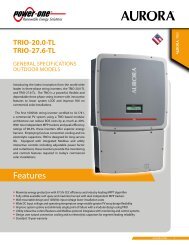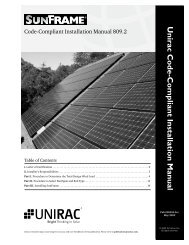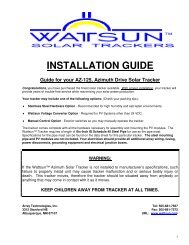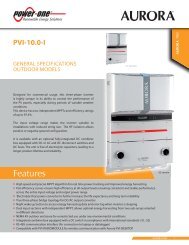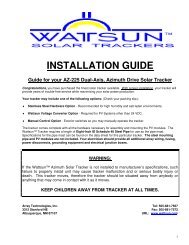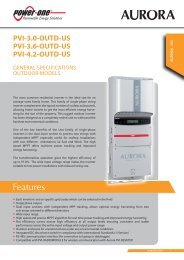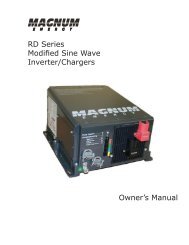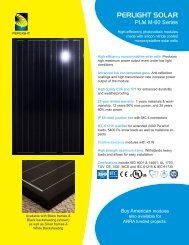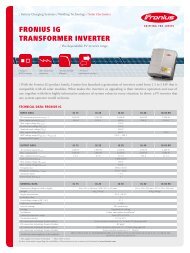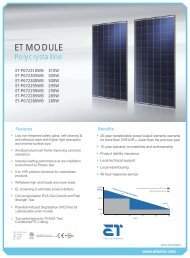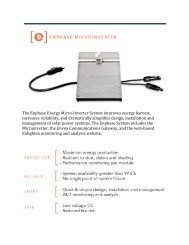MS Series Owner's Manual - Magnum Energy
MS Series Owner's Manual - Magnum Energy
MS Series Owner's Manual - Magnum Energy
Create successful ePaper yourself
Turn your PDF publications into a flip-book with our unique Google optimized e-Paper software.
Installation<br />
2.6.2 System Bonding Jumper<br />
The <strong>MS</strong> <strong>Series</strong> inverter does not include an internal bond between the Grounded Conductor (AC<br />
neutral/DC negative) and the equipment grounding terminals. This bond [System Bonding Jumper<br />
(SBJ)] is usually done in the main distribution panel for each electrical system.<br />
CAUTION: There should be one and only one point in each electrical system<br />
(both AC and DC) where the Grounded Conductor is attached to the Grounding<br />
Electrode Conductor.<br />
AC Side – The size of the System Bonding Jumper (SBJ) in the AC electrical system is based on<br />
the area of the largest AC ungrounded conductor. In accordance with the NEC, use Table 2-4 to<br />
determine the System Bonding Jumper size compared to the largest AC ungrounded conductor.<br />
DC Side - The size of the System Bonding Jumper (SBJ) in the DC electrical system must not be<br />
smaller than the DC Grounding Electrode Conductor (GEC – DC) used, which is determined from<br />
the grounding method that will be used (see section 2.6.1).<br />
2.6.3 Equipment Grounding Conductor<br />
The inverter case and all other non-current-carrying exposed metal surfaces in the entire electrical<br />
system that may be accidentally energized must be grounded. The equipment-grounding conductor<br />
must be sized to safely carry the maximum ground-fault current likely to be imposed on it from<br />
where a ground-fault may occur. In accordance with the NEC, use Table 2-5 to size the equipmentgrounding<br />
conductors. This table requires that the equipment-grounding conductor be sized<br />
according to the rating of the overcurrent device protecting the circuit.<br />
CAUTION: The connections and wiring for the equipment-grounding conductor must<br />
be continuous to allow fault currents to properly operate overcurrent devices. Where<br />
equipment is removed and this disconnects the bonding connection between the<br />
grounding electrode conductor and exposed conducting surfaces, a bonding jumper<br />
must be installed while the equipment is removed.<br />
AC Side - Where the AC output from the inverter is connected to an AC load center, there should<br />
be an equipment grounding conductor connected between the inverter case and the grounding<br />
point in the AC load center. The AC Equipment Grounding Conductor (EGC – AC) is sized per Table<br />
2-5 and is connected to the inverter’s AC equipment grounding terminal shown in figure 2-10.<br />
DC Side - Since the currents on the DC side are higher than the AC side (10 times at 12 volts,<br />
5 times at 24 volts), the equipment grounding needs are different. The DC Equipment Grounding<br />
Conductor (EGC – DC) is sized per Table 2-5 and connected to the DC equipment grounding terminal<br />
on the inverter shown in figure 1-2 (item 7).<br />
Table 2-5, Equipment Grounding Conductor Sizing<br />
Rating of Overcurrent<br />
Device<br />
Minimum Size of Copper<br />
Ground Wire<br />
15 amp #14 AWG<br />
20 amp #12 AWG<br />
30 - 60 amp #10 AWG<br />
100 amp #8 AWG<br />
200 amp #6 AWG<br />
300 amp #4 AWG<br />
400 amp #3 AWG<br />
© 2009 <strong>Magnum</strong> <strong>Energy</strong> Inc.<br />
Page 33




